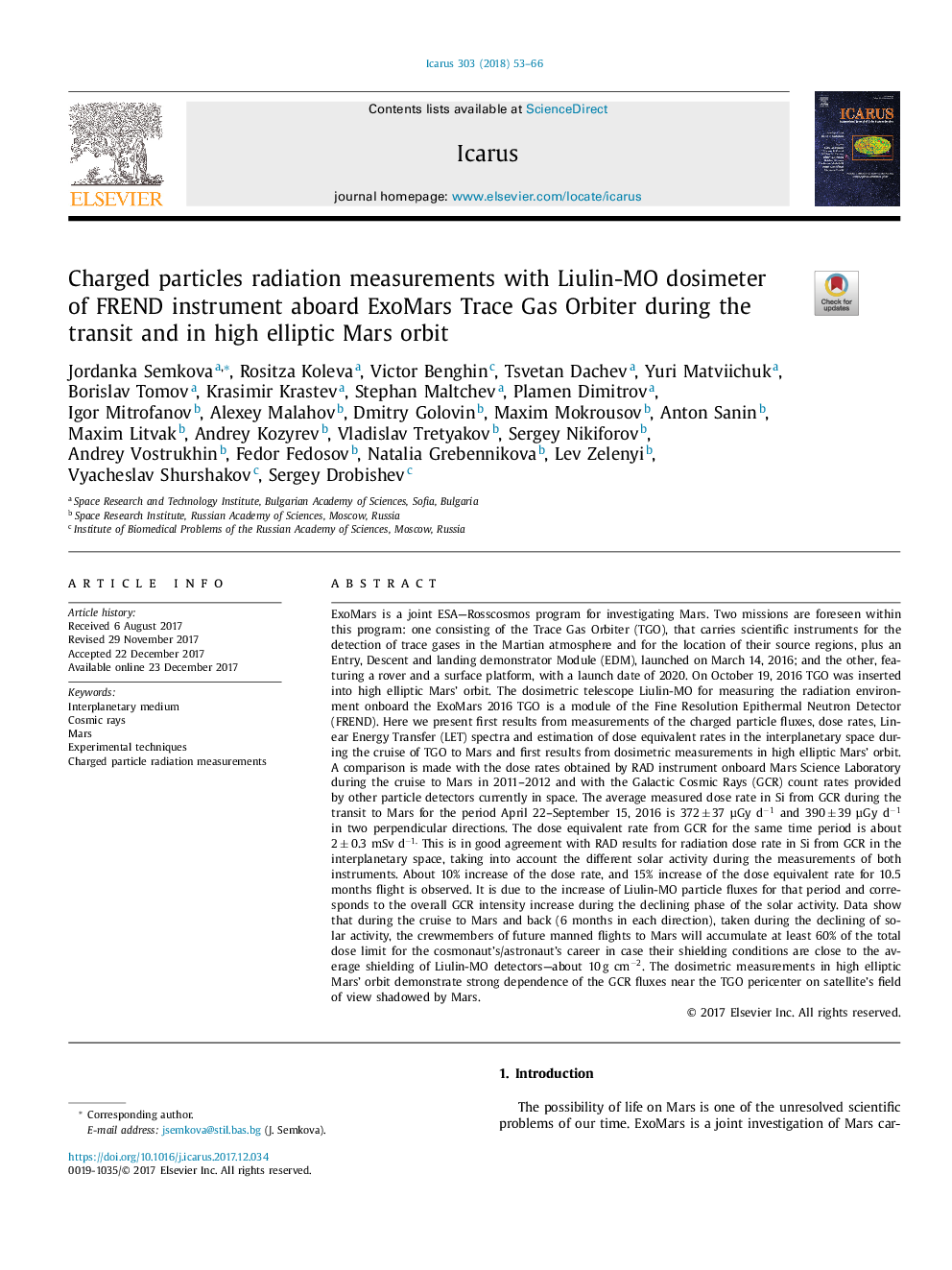| Article ID | Journal | Published Year | Pages | File Type |
|---|---|---|---|---|
| 8134406 | Icarus | 2018 | 14 Pages |
Abstract
ExoMars is a joint ESA-Rosscosmos program for investigating Mars. Two missions are foreseen within this program: one consisting of the Trace Gas Orbiter (TGO), that carries scientific instruments for the detection of trace gases in the Martian atmosphere and for the location of their source regions, plus an Entry, Descent and landing demonstrator Module (EDM), launched on March 14, 2016; and the other, featuring a rover and a surface platform, with a launch date of 2020. On October 19, 2016 TGO was inserted into high elliptic Mars' orbit. The dosimetric telescope Liulin-MO for measuring the radiation environment onboard the ExoMars 2016 TGO is a module of the Fine Resolution Epithermal Neutron Detector (FREND). Here we present first results from measurements of the charged particle fluxes, dose rates, Linear Energy Transfer (LET) spectra and estimation of dose equivalent rates in the interplanetary space during the cruise of TGO to Mars and first results from dosimetric measurements in high elliptic Mars' orbit. A comparison is made with the dose rates obtained by RAD instrument onboard Mars Science Laboratory during the cruise to Mars in 2011-2012 and with the Galactic Cosmic Rays (GCR) count rates provided by other particle detectors currently in space. The average measured dose rate in Si from GCR during the transit to Mars for the period April 22-September 15, 2016 is 372â¯Â±â¯37 µGy dâ1 and 390â¯Â±â¯39 µGy dâ1 in two perpendicular directions. The dose equivalent rate from GCR for the same time period is about 2â¯Â±â¯0.3 mSv dâ1. This is in good agreement with RAD results for radiation dose rate in Si from GCR in the interplanetary space, taking into account the different solar activity during the measurements of both instruments. About 10% increase of the dose rate, and 15% increase of the dose equivalent rate for 10.5 months flight is observed. It is due to the increase of Liulin-MO particle fluxes for that period and corresponds to the overall GCR intensity increase during the declining phase of the solar activity. Data show that during the cruise to Mars and back (6 months in each direction), taken during the declining of solar activity, the crewmembers of future manned flights to Mars will accumulate at least 60% of the total dose limit for the cosmonaut's/astronaut's career in case their shielding conditions are close to the average shielding of Liulin-MO detectors-about 10â¯g cmâ2. The dosimetric measurements in high elliptic Mars' orbit demonstrate strong dependence of the GCR fluxes near the TGO pericenter on satellite's field of view shadowed by Mars.
Related Topics
Physical Sciences and Engineering
Earth and Planetary Sciences
Space and Planetary Science
Authors
Jordanka Semkova, Rositza Koleva, Victor Benghin, Tsvetan Dachev, Yuri Matviichuk, Borislav Tomov, Krasimir Krastev, Stephan Maltchev, Plamen Dimitrov, Igor Mitrofanov, Alexey Malahov, Dmitry Golovin, Maxim Mokrousov, Anton Sanin, Maxim Litvak,
